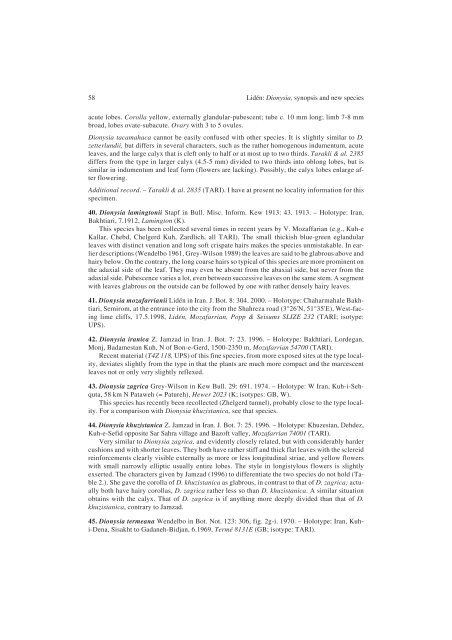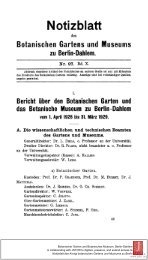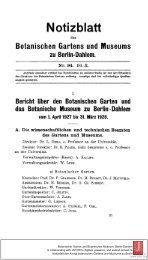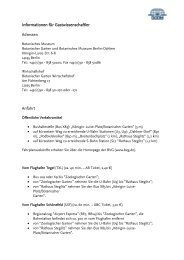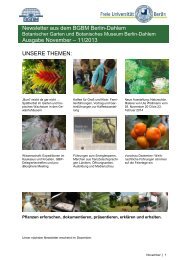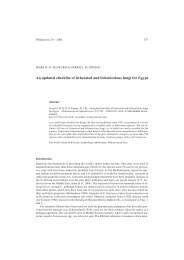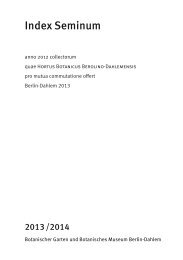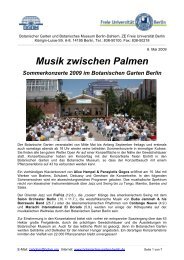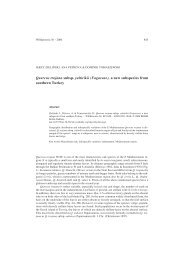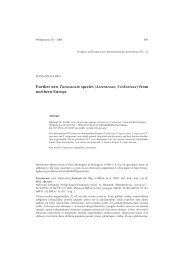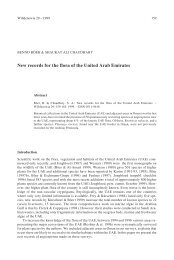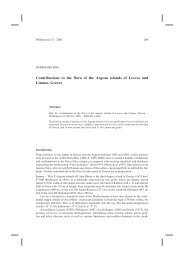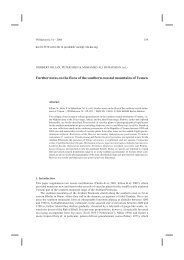The genus Dionysia (Primulaceae), a synopsis and five new species
The genus Dionysia (Primulaceae), a synopsis and five new species
The genus Dionysia (Primulaceae), a synopsis and five new species
Create successful ePaper yourself
Turn your PDF publications into a flip-book with our unique Google optimized e-Paper software.
58 Lidén: <strong>Dionysia</strong>, <strong>synopsis</strong> <strong>and</strong> <strong>new</strong> <strong>species</strong><br />
acute lobes. Corolla yellow, externally gl<strong>and</strong>ular-pubescent; tube c. 10 mm long; limb 7-8 mm<br />
broad, lobes ovate-subacute. Ovary with 3 to 5 ovules.<br />
<strong>Dionysia</strong> tacamahaca cannot be easily confused with other <strong>species</strong>. It is slightly similar to D.<br />
zetterlundii, but differs in several characters, such as the rather homogenous indumentum, acute<br />
leaves, <strong>and</strong> the large calyx that is cleft only to half or at most up to two thirds. Tarakli & al. 2385<br />
differs from the type in larger calyx (4.5-5 mm) divided to two thirds into oblong lobes, but is<br />
similar in indumentum <strong>and</strong> leaf form (flowers are lacking). Possibly, the calyx lobes enlarge after<br />
flowering.<br />
Additional record.–Tarakli&al. 2835 (TARI). I have at present no locality information for this<br />
specimen.<br />
40. <strong>Dionysia</strong> lamingtonii Stapf in Bull. Misc. Inform. Kew 1913: 43. 1913. – Holotype: Iran,<br />
Bakhtiari, 7.1912, Lamington (K).<br />
This <strong>species</strong> has been collected several times in recent years by V. Mozaffarian (e.g., Kuh-e<br />
Kallar, Chebd, Chelgerd Kuh, Zardlich, all TARI). <strong>The</strong> small thickish blue-green egl<strong>and</strong>ular<br />
leaves with distinct venation <strong>and</strong> long soft crispate hairs makes the <strong>species</strong> unmistakable. In earlier<br />
descriptions (Wendelbo 1961, Grey-Wilson 1989) the leaves are said to be glabrous above <strong>and</strong><br />
hairy below. On the contrary, the long coarse hairs so typical of this <strong>species</strong> are more prominent on<br />
the adaxial side of the leaf. <strong>The</strong>y may even be absent from the abaxial side, but never from the<br />
adaxial side. Pubescence varies a lot, even between successive leaves on the same stem. A segment<br />
with leaves glabrous on the outside can be followed by one with rather densely hairy leaves.<br />
41. <strong>Dionysia</strong> mozafarrianii Lidén in Iran. J. Bot. 8: 304. 2000. – Holotype: Chaharmahale Bakhtiari,<br />
Semirom, at the entrance into the city from the Shahreza road (3°26'N, 51°35'E), West-facing<br />
lime cliffs, 17.5.1998, Lidén, Mozafarrian, Popp & Seisums SLIZE 232 (TARI; isotype:<br />
UPS).<br />
42. <strong>Dionysia</strong> iranica Z. Jamzad in Iran. J. Bot. 7: 23. 1996. – Holotype: Bakhtiari, Lordegan,<br />
Monj, Badamestan Kuh, N of Bon-e-Gerd, 1500-2350 m, Mozafarrian 54700 (TARI).<br />
Recent material (T4Z 118, UPS) of this fine <strong>species</strong>, from more exposed sites at the type locality,<br />
deviates slightly from the type in that the plants are much more compact <strong>and</strong> the marcescent<br />
leaves not or only very slightly reflexed.<br />
43. <strong>Dionysia</strong> zagrica Grey-Wilson in Kew Bull. 29: 691. 1974. – Holotype: W Iran, Kuh-i-Sehquta,<br />
58 km N Pataweh (= Patureh), Hewer 2023 (K; isotypes: GB, W).<br />
This <strong>species</strong> has recently been recollected (Zhelgerd tunnel), probably close to the type locality.<br />
For a comparison with <strong>Dionysia</strong> khuzistanica, see that <strong>species</strong>.<br />
44. <strong>Dionysia</strong> khuzistanica Z. Jamzad in Iran. J. Bot. 7: 25. 1996. – Holotype: Khuzestan, Dehdez,<br />
Kuh-e-Sefid opposite Sar Sahra village <strong>and</strong> Bazoft valley, Mozafarrian 74001 (TARI).<br />
Very similar to <strong>Dionysia</strong> zagrica, <strong>and</strong> evidently closely related, but with considerably harder<br />
cushions <strong>and</strong> with shorter leaves. <strong>The</strong>y both have rather stiff <strong>and</strong> thick flat leaves with the sclereid<br />
reinforcements clearly visible externally as more or less longitudinal striae, <strong>and</strong> yellow flowers<br />
with small narrowly elliptic usually entire lobes. <strong>The</strong> style in longistylous flowers is slightly<br />
exserted. <strong>The</strong> characters given by Jamzad (1996) to differentiate the two <strong>species</strong> do not hold (Table<br />
2.). She gave the corolla of D. khuzistanica as glabrous, in contrast to that of D. zagrica; actually<br />
both have hairy corollas, D. zagrica rather less so than D. khuzistanica. A similar situation<br />
obtains with the calyx. That of D. zagrica is if anything more deeply divided than that of D.<br />
khuzistanica, contrary to Jamzad.<br />
45. <strong>Dionysia</strong> termeana Wendelbo in Bot. Not. 123: 306, fig. 2g-i. 1970. – Holotype: Iran, Kuhi-Dena,<br />
Sisakht to Gadaneh-Bidjan, 6.1969, Termé 8131E (GB; isotype: TARI).


